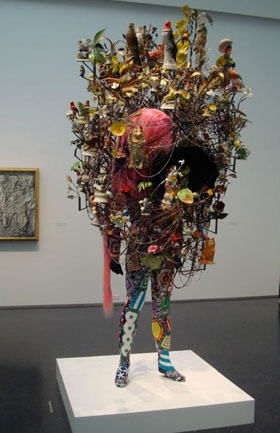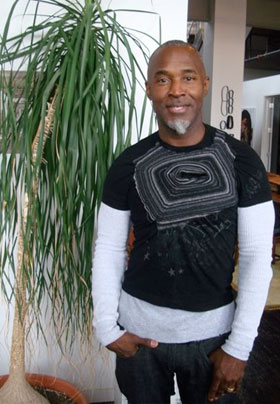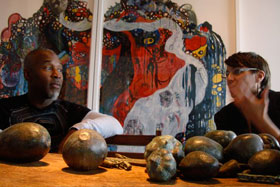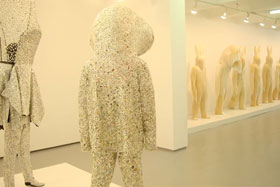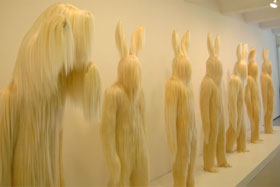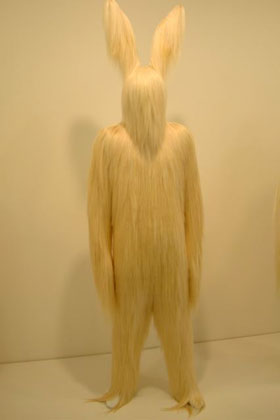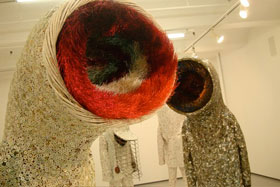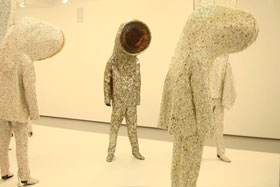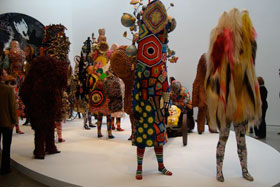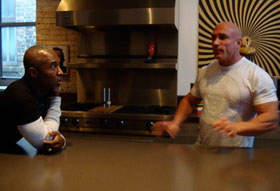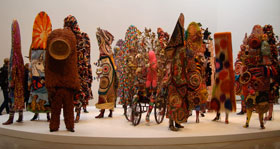|
|||||||||||||
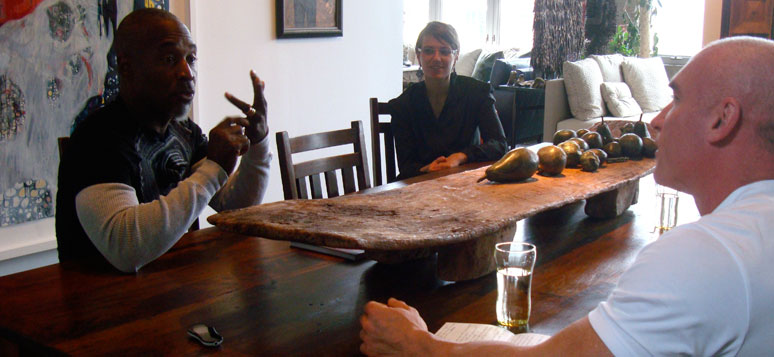 |
|||||||||||||
| Cave, Pope y Batalla. Foto Dany Barreto | |||||||||||||
Contanos algo acerca de tus comienzos.
Nací en Missouri y tengo siete hermanos. Siempre hice arte y fui artista. Estudié danza contemporánea con Alvin Ailey. Después me gradué en el Kansas City Institute y fui a hacer mi máster en Bloomfield. Pero el movimiento y la danza me interesan desde que tengo recuerdo. ¡Hasta en la escuela secundaria organizaba desfiles! Siempre junté a la gente creando proyectos. Es algo muy natural, como parte de mi ser. Y soy un hacedor, eso significa que no puedo quedarme conque hago escultura, performance o cualquier otra cosa; mi trabajo es muy interdisciplinario. Sí, me parece que ni vos mismo te sorprenderías de hallarte un día haciendo algo muy diferente, como por ejemplo…
Ser un fisicoculturista, jaja. Jaja, sí. Algo aparentemente alejado de las artes visuales.
Bueno, el trabajo debe ir evolucionando.
El tuyo tiene mucho que ver con transformaciones. También tenés una carrera como diseñador de ropa. ¿Todavía trabajas en algo relativo a la moda? Sigo haciendo colecciones. No todo el tiempo, pero si decido que haré una, me dedico completamente a ello. Me lo tomo tan en serio como el trabajo que realizo como artista. Es todo lo mismo para mí, se trata de la creatividad y de mantenerme abierto a ella como práctica. Es un estado mental. Elegí la opción de dedicarme a eso como modo de vida. No podría hacer otra cosa, así que tuve que encontrar el modo de hacer que todo funcione. Es un estilo de vida y debo procurarme las situaciones y condiciones para tornar esto en una fiesta. Un día estábamos comiendo y hablando acerca de relaciones, y me decían "cuándo vas a encontrar una pareja"; y yo les dije: "no lo sé, creo que estoy casado con el arte". Así que le pedí a un amigo en New York que es diseñador de joyas que hiciera este anillo para mí (se lo quita y lo muestra), con una inscripción en su interior. Dice "casado con el arte". Como que me di cuenta de lo fuerte que es mi compromiso.
Crecí en un contexto católico. Y ahí teníamos a las monjas, de las que muchos se ríen porque ellas sostienen que están casadas con Cristo. A mí me gusta pensar que lo creen, lo de estar casadas con Cristo, porque sino sería estúpido pasarse la vida haciendo algo en lo que no creen. Deben tener ese compromiso.
Sí. Cuando pensé cómo iría a vivir en el futuro, comprendí que todo tiene que ver con el amor y el compromiso que uno pone en algo. Puede ser mucho, pero es grandioso.
Hablando de grandes asuntos, supongo que la evidente búsqueda transformativa que subyace en todas tus muestras debe estar conectada con la idea de que la naturaleza humana también debe transformarse y alcanzar otro estado de consciencia.
Bueno, no creo ser un artista por delante de todo. Creo que soy primero un mensajero, y después un artista. Ahora al hacer los shows de New York en las galerías de Jack y Mary (1), al terminar de instalarlos me di vuelta y los supe listos. Podía salir de ahí y dejarlos atrás, las obras harían lo que deben hacer. Sin apego por nada. Te dije que me siento como un mensajero, y esa fue la primera vez que experimenté esta clase de sentimiento.
Lo que pensás sobre influencias, inspiraciones. Todo en alguna medida es una influencia de no sé bien qué. Pero creo que debemos largar todo eso al mundo. Por ejemplo, pueden aparecer cosas muy políticas, trabajos donde ese ángulo se enfatiza fuertemente, pero la operación debe continuar siendo la de darle un giro a eso. Como artistas debemos tomar decisiones sobre cómo hacer que el público se enganche con la obra. Descubrir cuáles son las medidas adecuadas para que entren. Y una vez que están dentro, ahí tengo la opción de decidir qué quiero hacer con ellos. Ese es un lado más oscuro.
Abriste una tienda, Soundsuit Shop, a la que le está yendo muy bien. Ahí se venden objetos de diseño ligados con tus obras. Estoy seguro de que parte del staff del mundo del arte debe tener una opinión formada acerca de esto.
Todo depende de cómo la posicione, creo que debo ser inteligente y calcularlo. Sé cuándo conviene mostrar la tienda y cuándo no. Lo malo es que, al final, todo se trata de hacer dinero. No estaría en mi galería si no vendieran mis obras. Me interesa apretar esas teclas.
Me temo que debes haber apretado las teclas del tipo de curadores que quieren ver a los artistas como novias de blanco, viviendo en un mundo "en proceso", sin preocuparse por las ventas ni por las compras de cada día.
No pensaría en hacer arte para vender. Tengo un trabajo también. Soy profesor en el Art Institute de Chicago. Las carreras artísticas están llenas de subidas y bajadas. Pero, como decía, no me asusta poner a mi identidad por delante mío y apretar esas teclas. Quiero dar esa discusión acerca del comercio. En verdad estoy interesado en la reventa, en los objetos. Pensaba el otro día mientras volaba de vuelta de Dallas que me gustaría volver a abrir un negocio. Y en el negocio habría de todo aquello en lo que creo. Eso es lo que tenemos que hacer, eso es lo que el mundo precisa ver. ¿Porqué no crear un ámbito en el que la gente tenga una suerte de experiencia? Sería crear un negocio como esto (Nick señala hacia su living room). Podrían venir aquí y comprarse todo: la mesa, el dormitorio completo. ¿Cómo enseñamos la estética de vivir con arte?
Eso lleva a mi pregunta habitual sobre este momento en particular de las artes visuales. 2011.
Está muy duro ahora. Y creo que es una gran oportunidad para los artistas de tener ideas que nos lleven a jugar nuevamente con sueños. Vivimos en un mundo que no sueña más. Y si puedo hacer algo que ayude a que dudes de tus certezas, esa es una misión. Creo que es importante. Ahora las galerías están cerrando. Tenemos que pensar en formas alternativas de llevar la obra afuera, al público. Yo tengo una galería, pero estoy más interesado en ver cómo insertar mi trabajo en la comunidad. En mantener a la gente excitada y estimularla a ser creativa. Actualmente estoy trabajando en un proyecto en Dallas que está basado en la comunidad. Creo que eso es lo que debemos hacer. Estamos en una recesión que se vuelve más intensa y una buena parte de la población está para atrás y no va a ir a los museos. Creo que no podemos pensar solo en galerías cuando pasan esta clase de cosas. Tenemos que pensar en otros proyectos. Lo que sucede en New York es buenísimo, pero tenemos que crear esta clase de proyectos que realmente están motorizados por nuestra responsabilidad como artistas. Puede ser muy bueno trabajar con mi galería, pero ellos tienen sus propios objetivos y yo tengo el mío: se trata de que el arte alcance a la gente.
¿Cómo es desarrollar una carrera aquí en Chicago con respecto a hacerlo en New York? ¿Cómo es la comunidad artística de aquí?
Son muy diferentes, pero vas a encontrar un camino adonde quiera que vayas. Y hay artistas orientados a trabajar con la comunidad en ambos lugares. Artistas que son eso y algo más después. Con un sentido de responsabilidad. Creo que es un tiempo crítico. Los artistas deben ser una suerte de motivadores, espíritus que ayuden a la gente a acomodarse en estos tiempos de transición.
Divertido y fresco no son términos usuales que se apliquen al arte contemporáneo. Hay un espíritu celebratorio en tu trabajo. ¿Qué te parece? ¿Tiene tu obra un temperamento distinto al que campea en las artes visuales?
La motivación detrás del trabajo no es la de que sea diferente. Estas muestras en New York llegan en un momento muy crítico y oscuro de mi vida pero, al mismo tiempo, son mi salvación. Poniéndolo en perspectiva, quiero que tengas una cierta respuesta, quiero que te vayas de la exhibición pensando "qué voy a hacer con mi vida". No quiero que te vayas pensando en mi trabajo, sino en vos. Haciéndote preguntas sobre vos mismo. Pensando "debo poner toda mi mierda junta". Para mí visitar las muestras es como verme en un espejo, y puedo juntarme ahí. (1) Las galerías neoyorquinas Jack Shainman y Mary Boone Married to ArtNick Cave: interview at his home studio in Chicago
Tell us something out your childhood, your raising.
I was born in Missouri and have seven brothers. I always have done art, have been an artist. Studied modern dance with Alvin Ailey. Then got my degree at the Kansas City Institute, and went to Bloomfield for my master. But I have always been interested in movement, in dance. Even in undergraduate school I did parades. I always pulled people together to create a project. So, it´s something very natural, sort of part of my being. I am a maker, that means I can´t just say that I do sculpture, or I do performance, my work is very interdisciplinary. Yes, I think that even you wouldn´t be surprised to find yourself doing something very different one day, as for example…
To be a bodybuilder, haha. Haha, yes. Something apparently far from visual arts.
You know, your work must keep evolving.
Well, your work has so much to do with transformation. You also have a career as cloth designer. Do you still work in anything related to fashion? I still do collections. Not all the time, but if I decide that it is what I gonna do, I completely commit myself to it, I take it as seriously as the work that I do as an artist. It is all the same for me. It is all about creativity and be open to it as a practice. Is a state of mind. I made the choice to commit myself to that as a lifestyle. I could´t do anything else, so I sorta had to find how all this would gonna work. Nothing else works for me. It is a way of life and I have to find the proper conditions and situations to transform this in a follie. One day we were having dinner and talking about relationships, and they were saying "when are you going to find a partner"; and I said "I don´t know, I think I am married to art". So I asked a friend in New York who is a jewell designer to make this ring for me (shows it), with a sort of brand engraved in its interior. It says "married to art". I sort of realized how strong my commitment is.
I was raised in a Catholic context. And there we had those nuns, that everybody laughs at, because they sustain that they are married to Christ. But I think that they must believe that they are married to Christ, because if not it would be stupid to spend their lives doing something which they don´t believe in. They should have that commitment.
Yes. When I sorted out what way I would live in the future, I realized that everything has to do with the love and commitment one puts in something. It´s sorta really big, but it is great.
Talking about big issues, I guess that the evident quest for transformation that underlines all your shows should be connected with the idea of human nature being transformed and reaching another state of consciousness.
See, I don´t think I am an artist first. I think I am first a messenger, and then an artist. Now, when I did these two shows in New York at Jack and Mary (1), when I finished the install I turned back and looked at the settings. And then I knew I could walk out the door and live them behind, thay they would do their thing. So there is no attachment to anything. I told you I feel as a messenger, that was the first time I experienced this sort of feeling.
Your thoughts on influences, inspirations.
Anything in some degree is an influence of I don´t know what. But I think is important that we throw all of it into the world. There may be things that are very political, maybe there are pieces where that becomes stronger, but still the operation is to give a kind of twist to it. We as artists have to make decisions on how to get on audiences to become engaged in the work. You have to find what are the proper measures that you need to take to get someone into your work. And once they are in it, then I have the option to decide what I want to do with them, that is a darker side.
Now you have set up a shop, Soundsuit Shop, that´s doing very well. There you sell design objects related to your work. Well, I am sure some of the art world staff may have an opinion on it.
It is all about positioning, I think you have to be smart. It´s all about how is done, it must be calculated. I mean, I know when to put it out and I know when to put it back. The unfortunate thing is that, you know, in the end of the day is all about making money; I wouldn´t be with my gallery if my work was not sold. I am interested in pushing those buttons.
I fear you must have pushed those of the kind of curators that want to see artists as white brides, living in a world "in process", without care for sales and your everyday groceries.
I wouldn´t think in making art for sale. See, I have a job too. I am a professor at the Art Institute of Chicago. Art careers can be full of up and downs. But as I told you I am not scared of putting my identity in front of me, and pushing those buttons. I want to have the conversation about commerce. Actually I am interested in retail, in objects. I was thinking the other day flying back from Dallas that I would love to open a store, again. And inside the store there would be anything that I believe in. That is what we need to do, that is what the World needs to see. Why not create an environment in which people can have a sort of experience? It would be to create a store like this (Nick points to his living room). You can come in here and buy everything: the table, the whole bedroom. How we teach the aesthetics of living with art?
That comes to my usual question about this particular moment of visual arts. 2011.
Well, it is very hard right now. And I think that this is a critical opportunity for artists to create those ideas that take us back to play with dream. We live in a world where we don´t dream anymore. And if I can do something that helps interrogate about your beliefs and get people back to it, that´s a mission. I think it is important. Now galleries are closing. We have to think alternate ways to get the work out and into the public. I have a gallery, but I am more interested in how to get the work into the community. In keeping people thrilled and estimulate them in being creative. Presently I am working at a project in Dallas which is community based. I think that is what we have to do. We are in a recession that is getting more intense and a large population won´t go to the museums because when there is recession everybody pulls back. I think we can´t rely in our galleries when this kind of things happen. We must think of other projects. What is happening in New York is fine, but we also have to start to create this sort of projects that really are motored and motivated by our responsibilities as artists. At the end of the day, my gallery is amazing to work with, but they have their mission, I have my own mission, and my mission is about art reaching people.
How is to develop a career here in Chicago respect to doing that in New York? How is the artistic community here?
Being very different, you will find your way wherever you go, and community oriented artists grow in both places. Artists that are so and something else beyond. That have a sense of responsability. See, I think this is a critical time. Artists have to be sort of motivators, spirits that help people to accommodate in these transitional moments.
Fun and fresh are not words usually applied to contemporary art. There is a celebratory spirit in your work. What do you think about that? Is a different temperament the one of your works, compared to the one that rules among visual arts?
That is not the motivation behind it, to be different. This two shows in New York come in a very critical and dark moment of my life but, at the same time, they are my saviors. Putting it in perspective, I want you to have a kind of response, I want you to leave the exhibition thinking just about "what am I here to do with my life". I don´ t want you to leave thinking about my work, but about you. Making questions about yourself. Thinking "I must get my shit together". For me to visit the exhibitions is like to see myself in a mirror and I can put myself together there. (1) Jack Shainman and Mary Boone Galleries |
|||||||||||||
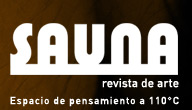 |
|||||||||||||||||||||||||||||||||||||||||||||||||||||||||||||||||||||||||||||||||||||||||||||||||||||||||||||||||||||||||||||||||||||||||||||||||||||||||||||||||||||||||||||||||||||||||||||||||||||||||||||||||||||||||||||||||
|
